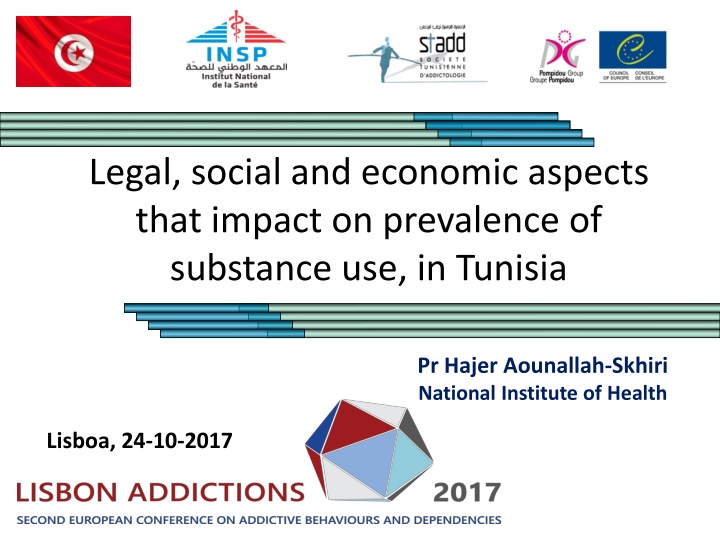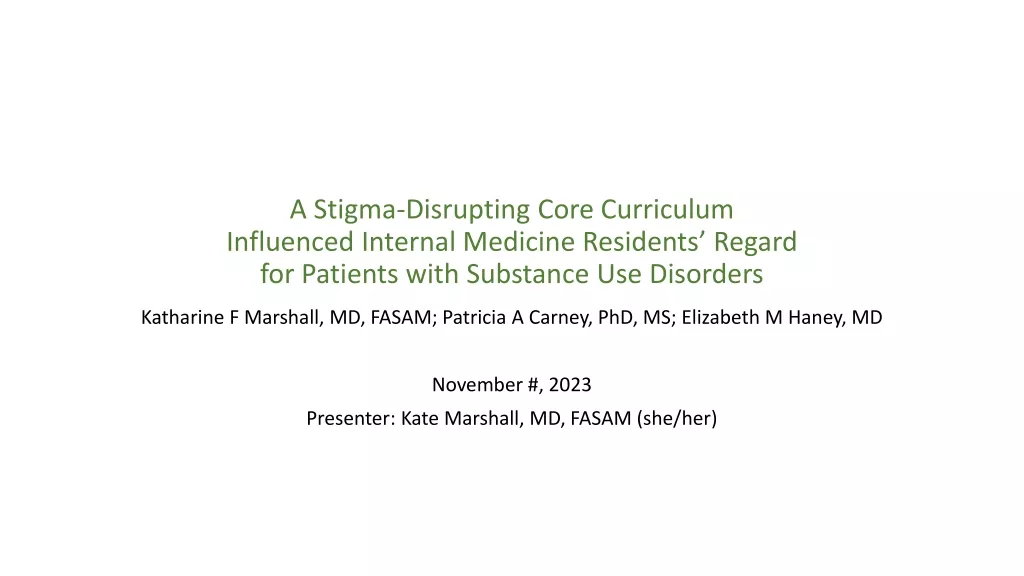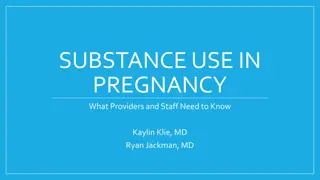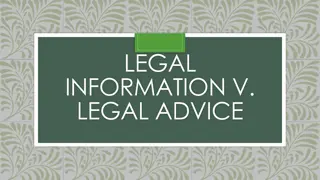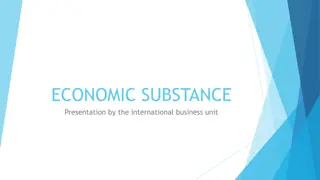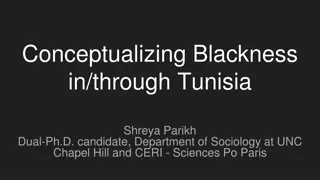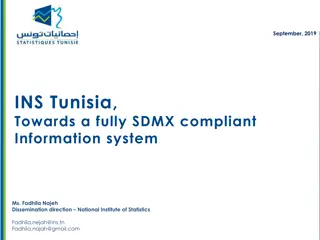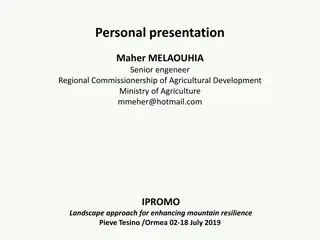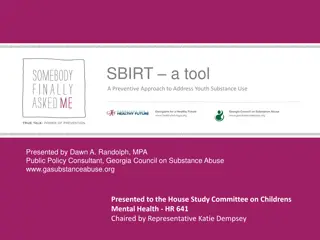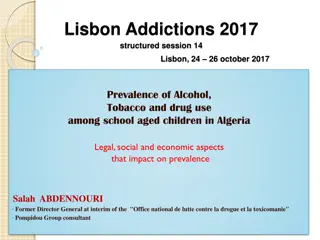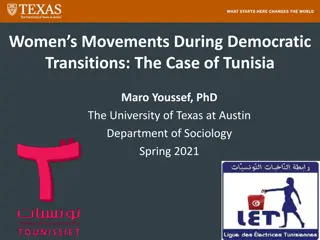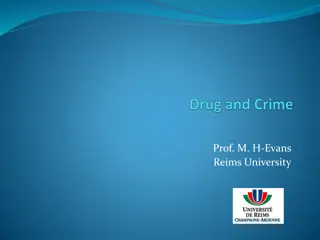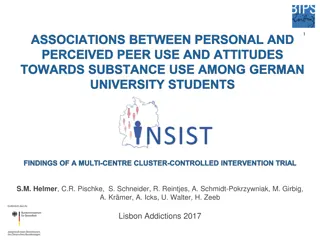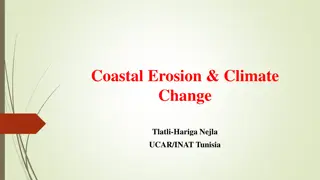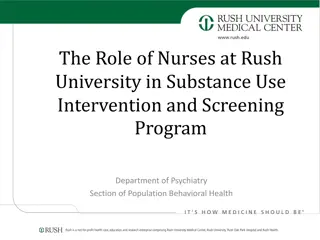Impact of Legal, Social, and Economic Factors on Substance Use in Tunisia
The presentation by Pr. Hajer Aounallah-Skhiri explores the legal, social, and economic aspects influencing substance use prevalence in Tunisia, focusing on data from national surveys and highlighting key factors such as legal frameworks, access to healthcare, and awareness of consequences related to substance consumption.
Download Presentation

Please find below an Image/Link to download the presentation.
The content on the website is provided AS IS for your information and personal use only. It may not be sold, licensed, or shared on other websites without obtaining consent from the author.If you encounter any issues during the download, it is possible that the publisher has removed the file from their server.
You are allowed to download the files provided on this website for personal or commercial use, subject to the condition that they are used lawfully. All files are the property of their respective owners.
The content on the website is provided AS IS for your information and personal use only. It may not be sold, licensed, or shared on other websites without obtaining consent from the author.
E N D
Presentation Transcript
Legal, social and economic aspects that impact on prevalence of substance use, in Tunisia Pr Hajer Aounallah-Skhiri National Institute of Health Lisboa, 24-10-2017
Introduction To provide some indicators / informations concerning legal, social and economic aspects that could impact on prevalence of substance use in Tunisia Using mainly the data from MedSPAD I Tunisia 2013 (15-17ans, n=3482) :I & II high level school Regional survey on drug use (Tunis-2013, n=795, mean age =17.6) : III high level school
Introduction Tunisia is a North African country Urban/rural areas 67%vs. 33% Tunisia =drugs stopping-off & consumption place 11 millions inhabitants
Tunisian Legal aspects Current Law 92 - 52 Sanctional approach Consumer at risk of being legally prosecuted/jailed Doctor must report to Justice any consumer No access to health care (HC) HC Centers not available Consumption Prevalence
Tunisian Legal aspects Law project 79-2015 Human rights & Health care access approach Amendment of one article of this law on 25 April 2017 by the APR: Judges have now the option to assess each case apart Support from civil society, the Ministry of Health and some Deputies
Alcohol consumption according to awareness about legal aspects 9.0 Alcohol's consumption (%) Knowing that alcohol consumption leads to legal proceeding 8.5 p< 10-3 8.0 Prevalence of last year 7.0 6.0 5.0 4.0 2.6 3.0 1.8 2.0 1.0 0.0 Yes No Don't know Association between prevalence of last year alcohol s consumption and awareness that alcohol consumption leads to legal proceeding (MedSPAD-Tunisia-2013)
Awareness about legal aspects 37.3 40 lifetime drug's consumption p< 10-4 Prevalence of students 35 30 25.0 25 (%) 20 14.7 15 10 5 0 No Yes Don't know Knowing that drug s consumption leads to legal proceeding Association between prevalence of lifetime drug s consumption and knowing that drug consumption leads to legal proceeding(MedSPAD I-Tunisia-2013)
Social factors associated with drug use Influence of peers Impact (influence) of peers 35 Prevalence of lifetime illicit drug's P<10-4 30.4 28.4 30 27.2 25 consumption (%) 20 15 10.4 8.4 10 5 2.0 0 Male Female Total Consumption of at least one type of illicit drug by friends No Association between peers drug use and student s drug use (MedSPAD I-Tunisia-2013 survey)
Social factors associated with drug use Influence of family 33.3 35 30.3 Prevalence of lifetime illicit drug s 28.6 30 P<10-4 25 consumption (%) 20 17.1 15 12.7 10.6 10 5 0 Male Female Total Lifetime illicit drug's consumption Illicit drug use by a family member No Association between family member s drug use and student s life time illicit drug use (MedSPAD I -Tunisia-2013)
Social factors associated with drug use Social environment 50 44.4 Lifetime illicit drugs use 41.7 45 40 p<10-3 p<10-3 by students (%) 35 28.6 p<10-3 30 25 20 12.2 15 11 10 6.5 5 0 Yes No Yes No Yes No Alcohol Illicit drug Psychotropic drugs People within the social environment consume People within the social environment consume (Drug use Survey among high school students in the governorate of Tunis, Feb 2013; n=795)
Social factors associated with drug use Relationship with social environment 35 28.3 30.0 29.3 Student s illicit drug use 30 p<10-3 p<10-3 25.0 25 prevalence (%) 20.0 20 15.4 14.7 15.0 15 10.0 10 5 5.0 0 0.0 Yes No Yes No Relationship's problems with family Relationship's problems with peers (Drug use Survey among high school students in the governorate of Tunis, Feb 2013; n=795)
Social factors associated with drug use Family context/relationship with mother 70 Prevalence of lifetime illicit drug use 60.8 60 p<10-3 p<10-3 p=0,04 50 38.0 40 28.1 30 23.6 22.9 22.3 (%) 20 10 0 1 night or over 0 night A working mother Housewife Unsatisfied Satisfied Number of nights spent outside home (during last 30 days) Mother's professionnal status Degree of satisfaction about his relationship with his mother Association between family situation, family relationship s problems and student s illicit drug use (MedSPAD I-Tunisia-2013)
Social factors associated with drug use Educational situation (school stress / performance) 70 58.0 60 p<10-3 p<10-3 47.0 50 Life time illicit drug use prevalence (%) p<10-3 p<10-3 40 33.5 27.5 27.4 27.0 30 21.2 19.2 20 10 0 > 1 day 0-1 day Yes No Yes No 12/20 > 12/20 Number of days absent from school Escape from the school Problems with the school Academic average during the third trimester of last year administration Reasons for absence Association between educational situation and student s illicit drug use (MedSPAD-Tunisia-2013 )
Social factors associated with drug use Relationship with teachers 35 Prevalence of student s illicit drug 28.9 p<10-3 30 25 20 use (%) 13.5 15 10 5 0 Yes No Relationship's problems with teachers (Drug use Survey among high school students in the governorate of Tunis, Feb 2013; n=795)
Social factors associated with drug use Level of mental and social well-being 45 42.8 Prevalence of lifetime illicit drug's 40 35 consumption (%) 34.4 30 24.5 25 Male 20 14.0 Female 20.5 15 10 10.2 5 0 Low Meduim High Level of mental and social well-being (MedSPAD I-Tunisia-2013)
Social factors associated with drug use Drug availability perception by gender The perception of illicit drug accessibility varied significantly by gender (p <10-3) : % of easy access was higher among boys. 46.3 Don't know 49.7 40.4 Total Illicit drugs 23.0 Difficult to very difficult 22.1 24.5 30.7 Easy to very easy 28.2 35.1 41.5 Don't know 46.0 33.8 Alcohol 10.8 Difficult to very difficult 10.9 10.6 47.7 Easy to very easy 43.1 55.6 (%) 0 10 20 30 40 50 60 (MedSPAD-Tunisia-2013)
Social factors associated with drug use Drug availability perception by gender p=0,0046 40 Male 33.6 p=0,023 35 31.4 Female 30 27.6 26.1 Pourcentage (%) Total 23.5 25 22.0 p=0,051 20 15 10 5.9 4.8 4.1 5 0 Students High school's employees Dealers Others Illicit drugs providers, by gender. (MedSPAD I-Tunisia-2013)
Social factors associated with drug use Drug availability perception by gender p= 0,00 70 p= 0,00 59.2 p= 0,003 60 53.7 50.5 50.2 50 43.0 43.6 40.9 p= 0,00 37.2 40 p= 0,94 32.4 (%) 26.0 30 14.9 20.8 20 14.8 14.7 11.7 10 0 Inside the high school Near the high school in the cafes and tea far from the high school in the amusement arcades and youth centers sports halls shops near the high school Male Female Total Illicit drugs purchase Places by gender (MedSPAD I-Tunisia-2013)
Socio-economical Tunisian context Social-economical difficulties can influence the behavior of individuals and can expose them to a further risk for drug abuse: The school dropout rate reached 63% at local level during 2015-2016 Unemployment (15,3% ,T1-20171), 1. http://www.ins.nat.tn/fr/themes/emploi
Socio-economical Tunisian context Precarious economic situation depressive tendency of a category of Tunisian population (low economic category (LEC)+++) Negative perception of the future in Tunisia by LEC poverty Perception of the inequity in health, education, employment chances, leisure (spaces, tools) Suicide incidence & illegal immigration & drug trafficking
Socio-economical Tunisian context 1800 Tunisian migrants reached Italy during the month of October 20171 http://www.huffpostmaghreb.com/news/immigration-clandestine-tunisie/
Economical influences 40 35.3 Prev. of student s iilicit p=0,04 35 30 26.2 drug use (%) 23.3 25 20 15 10 5 0 Under Economic situation of the family/others Above The same Relationship between the economic situation of the family & student s iilicit drug use (MedSPAD I -Tunisia-2013)
Conclusion The strategy to combat drug use should take into account all these risk factors. Failure to consider these factors leads to a vicious circle that worsens the situation (National & International) While Tunisia has made progress in the right direction in post revolution, however, it is crucial to reinforce the efforts of setting up an effective multi-sectoral strategy and taking into account the different levels of prevention.
Conclusion International collaboration Multisectoral strategy
Thank you for your attention Merci de votre attention
